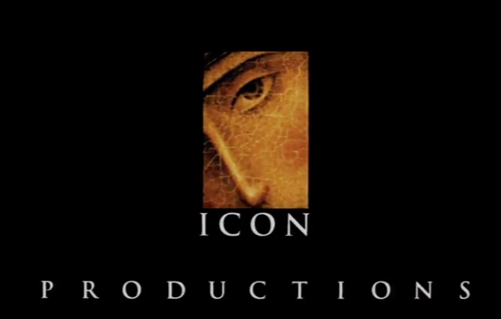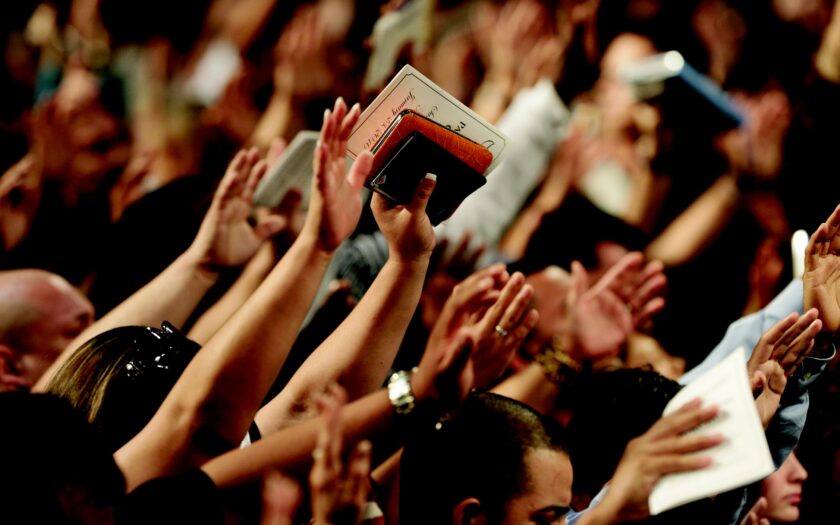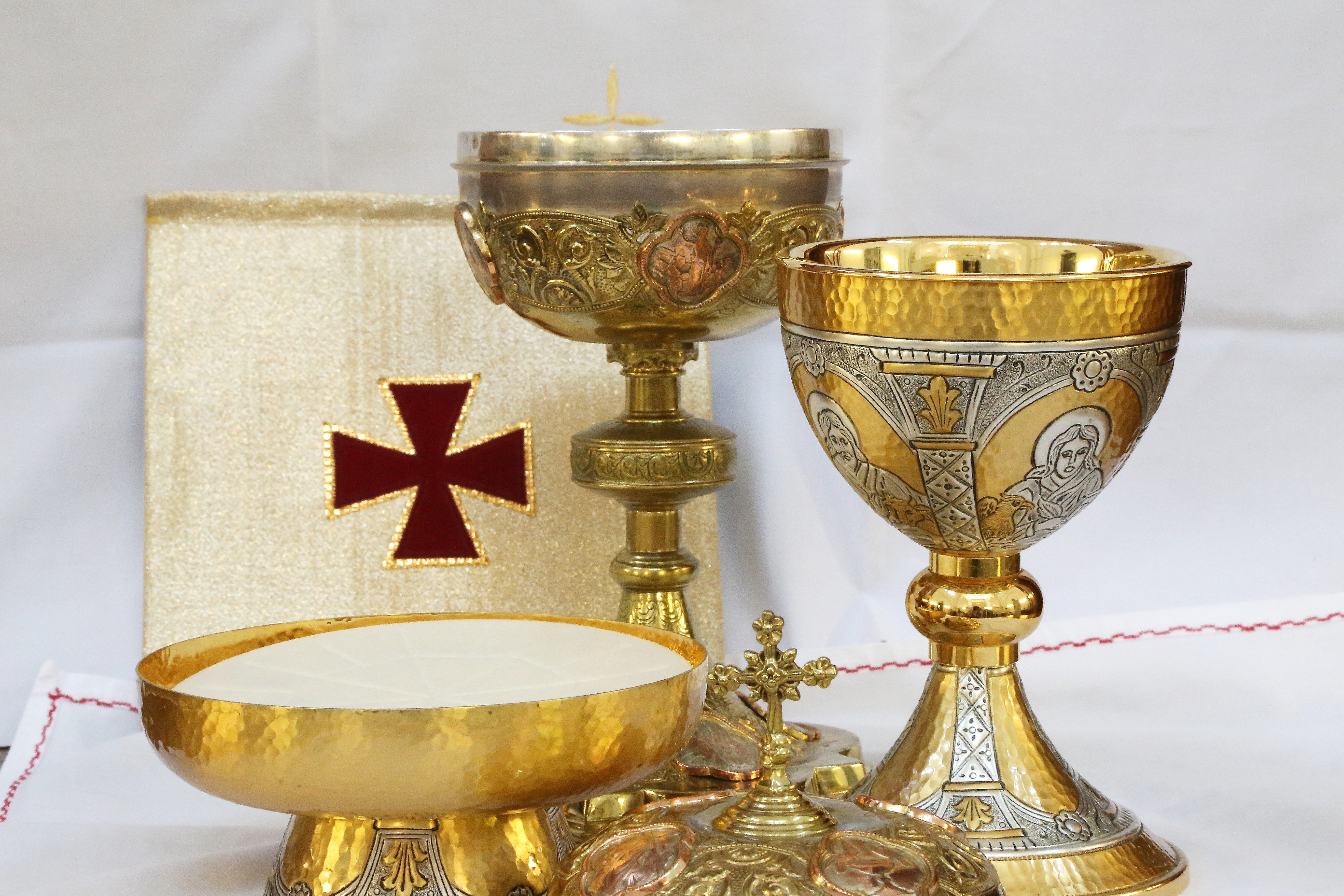The writer of the article below, T.A. McMahon, explains at the beginning of it what he means by "evangelical. It is broader than what we mean by it in the Netherlands. The article is a translation of a artikel van The Berean Call uit februari 2008 en geeft een beeld van de veranderingen in de Amerikaanse evangelische wereld in de afgelopen decennia.
Bij ons hebben zich soortgelijke veranderingen voltrokken en gaan nog steeds door. Dit artikel beschrijft de werkelijke standpunten van de roomse kerk als ook de misleidende roomse praktijken die de protestantse gemeenschappen overspoelen.
De tussenkopjes en streamers zijn van mij (TdJ)
These days I get sadder and sadder when I see what is happening among those who claim to be evangelical. I know that the term "evangelical" has undergone radical changes in terms of its meaning and practice. But when I use the term, I start from a very simple definition: I refer to those who claim to accept the Bible alone as their authority to know and receive God's way of salvation and to live their lives in a way that is pleasing to Him.
Thirty years ago (now in 2021 about45 years), it was young adult evangelicals who were miraculously used by the Lord to help open my eyes to the fact that I was eternally separated from God and that the religious system I depended on to get me into heaven was a false hope. That was not easy for me to accept at that time. Although my devotion to the Roman Catholic Church had weakened by my late twenties, the attitude "I was born a Catholic, I will die a Catholic" was woven into my spirit.
De Rooms Katholieke traditie
When I think back to those days, I realize that I was a young man living in bondage. Sure, I was bound by sin, like anyone who is not born again. But there was another bondage that gripped me: the bondage of the Roman Catholic tradition, with its sacraments, liturgies, rituals and sacraments. Not only were such things unbiblical - they were works of the flesh and tools of demons. In my own life, and also in the history of the Church of Rome, it was superstition that imprisoned the soul. Superstitious beliefs sold under the guise of spirituality.
I relied on relics of dead so-called saints; holy water; making the sign of the cross; votive candles; (children's) baptism for salvation; a "transubstantiated" piece of bread that was claimed to be Christ; apparitions of Mary; a scapular; a "miraculous medal"; statues and images of Jesus, Mary and the saints; endless rosaries, novenas, the Stations of the Cross; abstinence from meat on Fridays; abstentions in Lent; the last rites to get me into purgatory and indulgences to get me out of purgatory; Mass cards; graces of Mary; the confessional, with absolution of my sins by a priest; penance and personal suffering to purify me of my sins; worshiping a piece of bread during the Eucharistic Holy Hour; the Holy Father as Christ's substitute on earth, etc. , etc. Therein lies a bondage that few evangelicals understand.



Many dismiss these things as non-essentials of the Christian faith or minor theological errors unique to Catholicism. That's not true. They are essential to the gospel Rome proclaims - a gospel of meritorious works that the Bible condemns (see Galatians, Romans, Ephesians, et al.) as a rejection of the accomplished vicarious atonement of Christ, our Savior. The Roman Catholic Tradition said to be as authoritative as Scripture consists of those things (as cited above) that are necessary for, or supportive of, a Catholic's entrance into heaven.
Volgens het Woord van God is alles wat wordt toegevoegd aan het volbrachte werk van Christus aan het kruis een ontkenning van het evangelie: dat Christus de volledige straf heeft betaald voor de zonden van de mensheid.
Geen Bijbels evangelie
De Rooms Katholieke Kerk, die onfeilbaarheid claimt in haar concilies en theologische leerstellingen, ontkent duidelijk en nadrukkelijk het bijbelse evangelie. Het Concilie van Trente verklaart:
- 6th Session, Canon 9: If anyone says that the sinner is justified by faith alone, i.e., that nothing else is needed to cooperate in order to obtain the grace of justification...let him be anathema.
- 6th Session, Canon 12: If anyone shall say, that justifying faith is nothing but confidence in divine mercy, which for Christ's sake remits sins, or that it is this confidence alone by which we are justified, let him be anathema.
- 6e Zitting, Canon 30: Indien iemand zegt, dat na het ontvangen van de genade der rechtvaardiging de schuld zo is kwijtgescholden en de schuld der eeuwige straf zo is kwijtgescholden aan iedere berouwvolle zondaar, dat er geen schuld der tijdelijke straf overblijft, die noch in deze wereld, noch in het vagevuur moet worden kwijtgescholden, voordat de poorten des hemels kunnen worden geopend, laat hem dan anathema zijn.
- 7th Session, Canon 4: If anyone says that the sacraments of the New Law [canons and decrees of the Church] are not necessary for salvation, but ... without them ... man obtains from God by faith alone the grace of justification ... let him be anathema.
The "anathema," in these decrees (which are still in effect), condemns to hell anyone who rejects the false gospel of the Roman Catholic Church of works.
Starting with the Second Vatican Council in the 1960s, where only superficial changes were made (because infallible dogmas cannot be changed!), Rome launched an ecumenical program aimed at enticing Protestants around the world, and especially evangelicals in the United States. The goal was and is to bring all of Christendom under the rule of the Roman Catholic Church with the pope as spiritual head. Predictable progress has been made in Europe and the U.S. under liberal denominations that have long abandoned the scriptures. Amazing, however, is the success the plan has had among American evangelicals.
Rome begon in de jaren 60 van de vorige eeuw met het oecumenische verleidingsprogramma.
In the 60s - 70s an active demonic influence begins in all sectors of society. Resulting in what we see around us today: a world in chaos and misery, unable to extricate itself from Satan's grip.
In die zelfde tijd ontstond ook de 2e golf van de Pinksterbeweging, de charismatische beweging.
En de wereld kreeg in diezelfde tijd onder meer de Beatles and "flowerpower," with which Eastern spirituality and drugs began their tremendous advance. Thereby the New Age movement in the 70′s which also invaded - albeit in cover - the Protestant communities.
De Amerikaanse evangelischen
Billy Graham was de eerste en meest opmerkelijke evangelical die de oecumenische inspanningen van het katholicisme steunde. Anderen volgden, waaronder Bill Bright, Pat Robertson, J.I. Packer, Timothy George, Robert Schuller, Hank Hanegraaff, Benny Hinn, en Jack Van Impe. ‘Evangelicals and Catholics Together' led by Chuck Colson and Catholic priest Richard John Neuhaus, declared Catholics and Evangelicals to be "broeders en zusters in Christus" and urged them to work together in spreading the gospel. Clearly, this gospel was never defined.
Hoewel de aanvaarding van rooms-katholieke zaken onder evangelicals gestaag groeide in de jaren na Vaticanum II, nam het exponentieel toe met de populariteit van Mel Gibsons ‘The Passion of the Christ', an ultra-conservative Catholic. His dramatization of one of Catholicism's holiest rituals, the Stations of the Cross, captured the hearts of evangelicals so much that their eagerness to buy tickets en masse ensured the film's huge financial success. After this achievement,Inside the Vatican' this important note: "The film has given evangelicals a glimpse into the Catholic soul, even the traditional Catholic soul. Many evangelical believers, reflecting on what they have seen in the film, say they are beginning to 'understand' the whole Catholic thing: Lent...the ashes on the forehead...no meat on Fridays...the sad mysteries...the Stations of the Cross...the emphasis on the Eucharist...the devotion to Mary...the huge crucifix that hangs above every Catholic altar. They may not rush to buy rosaries, but some things no longer seem so strange, so alien." [1]

Icon Productions is the production company of "The Passion of the Christ."
'Icon Productions': a telling name when we consider that an icon is the entrance to another world.
What evangelicals also "got," and what their leaders enthusiastically endorsed as "biblically faithful," were numerous scenes based on the imagination of an 18th-century Catholic mystic, the depiction of Mary as co-redeemer in the redemption of mankind, and a very Catholic gospel that shows Christ atoning for sin by suffering the relentless physical torture of Roman soldiers.[2]
The "Passion of the Christ" had a stunning effect on evangelical youth and youth pastors. Not only did "Catholic things no longer seem so strange and alien," but they appeared in the youth services of evangelical churches. The ritual of the Stations of the Cross became popular, although it had to be reduced from 14 stations to 11, removing some stations that were too alien to Scripture (such as St. Veronica capturing the image of Christ's bloodied face on her veil). Prayer altars were erected with icons lit by candles and perfumed by burning incense, and prayer labyrinths were painted on large tarpaulins placed in church basements or carved into church lawns. For young evangelical believers, who were often brought up with empty, repetitive worship choirs that differed little from secular music, and religious instruction that relied heavily on entertainment to keep them interested, Catholic and Orthodox liturgies seemed much more spiritual.
The 'Emerging Church'
All this became "spiritual" fodder for the so-called Emerging Church Movement (ECM), largely a reaction against the consumer-oriented marketing approach to church growth popularized by Robert Schuller, Bill Hybels, and Rick Warren. Many ECM leaders, most of whom have evangelical backgrounds, saw Catholic ritual and mysticism as a necessary spiritual ingredient lost to evangelicals in the Reformation. Sola Scriptura was a major rallying cry of the Reformers against the abuses stemming from the Roman Catholic tradition; the Bible as one's sole authority practically ended the influence of the Catholic mystics known as the Desert Fathers.
Yet Catholic mysticism has returned with a certain vengeance. Its occult techniques can be found almost everywhere, from Youth Specialities and Richard Foster's I will renew organization to Rick Warren's Purposeful Living. "Many Christian leaders have been looking for a new approach under the heading of 'spiritual formation' (spiritual formation). This new quest has led many of them back to Catholic contemplative practices and medieval monastic disciplines," Brian McLaren writes approvingly.
Tony Jones, co-editor of An Emergent Manifesto of Hope has written a mystical manifesto for emerging churches ("emerging churches") entitled, "The Sacred Way: Spiritual Practices for Everyday Life" (The Holy Way: Spiritual Exercises for Everyday Life). Jones' listing of those who have supported his effort reads like a Who's Who of EC leaders, not to mention the Catholic priests he thanks and the ancient Orthodox and Catholic mystics he quotes. So what is this mysticism they propagate?
Katholieke mystiek
Catholic mysticism is subjective and experiential through and through. Like its mother, Eastern mysticism, it claims that God can neither be known nor understood by human reason, but can only be subjectively experienced through various techniques. It is the antithesis of what the Bible teaches: "Come now, and let us reason together, saith the Lord" ((Isaiah:1:18); "Wisdom is the main thing; therefore acquire wisdom, and with all your acquisitions acquire understandingt" (Proverbs:4:7); "As His divine power has given us all things of life and godliness through the knowledge of Him" (2 Peter:1:3). Moreover, the goal of mysticism is union with God, that is, the merging of one's soul into God. This is an impossibility that the pantheistic and panentheistic reveals the roots of mysticism, namely that God is all and is in all. No. God is infinite and transcendent, absolutely separated from his finite creation.
Mystical techniques have also gained widespread acceptance in the Netherlands. Many are promoting them, and the EO is also on the trail of the "Emerging Church" with "Lazarus" - a church that is not a church, without the Word of God and without Christ the crucified.
The Sacred Way (the aforementioned book by Jones) subscribes to numerous mystical techniques that are increasingly accepted by evangelicals today. An awareness and understanding of these techniques is therefore crucial for discernment.
Centering Prayer uses a single word (e.g., "love" or "God") on which to focus to clear the mind of all other thoughts. The belief is that the would-be bidder will hear directly from God in his silence before Him. Tony Campolo explains, "In my case, intimacy with Christ has developed gradually over the years, mainly through what Catholic mystics call 'centering prayer.' Every morning, as soon as I wake up, I take time - sometimes up to half an hour - to focus on Jesus. I say his name over and over again to dispel the 101 things that begin to clog my mind the moment I open my eyes. Jesus is my mantra, as some would say. "[3]
Het 'Jesus Prayer' have the praying person repeat a phrase like "Lord Jesus, have mercy on me" incessantly, hundreds, even thousands of times. The repetition would fix a person's mind on Jesus. Yet it is a blatant rejection of His commandment not to use vain repetitions in prayer, as the pagans do (Matthew 6:7). Moreover, constant repetition makes prayer as a form of communication with Jesus an act of nonsense.
Lectio Divina, which means "sacred reading," is a technique far removed from the normal reading and study of the Bible. The methodology aims to go beyond the objective meaning of the words and simple instructions to that which transcends normal consciousness. Jones writes, "As you pay attention to those deeper meanings, you begin to meditate on the feelings and emotions evoked within you. "[4] He then summarizes this mystical contemplative technique as follows "True contemplation moves beyond words and intellect and into that 'thin space' where time and eternity almost touch. It is in such moments that some of the greatest [Catholic] saints in the history of the [Catholic] Church have had a 'mystical union' with Christ." It is clear from God's Word that the spirit with which they had a "mystical union" in their contemplative altered state of consciousness was not Jesus.
Het 'Ignatian Exam' is an occult visualization technique taught by Ignatius of Loyola, who founded the Jesuits in the 16th century. His exercise teaches a person to visualize himself in the presence of Jesus and then interact with Him during His earthly events, e.g., "at the Last Supper and the Garden of Gethsemane, at the foot of the cross, and at the laying of Jesus' body in the tomb."[5] By doing so, one adds content to the Scriptures from one's imagination and opens oneself to demonic manipulation (2 Corinthians 11:4; Galatians 1:8).
Prayer Labyrinths are concentric paths created by the Catholic Church in the 13th century to experience in one's imagination Christ's Via Dolorosa, or "way of sorrows," as He carried His cross to the hill of Golgotha. Rather than submit to the dangers of a pilgrimage to Jerusalem during Holy Week, Roman Catholics in Europe could obtain the same indulgences (to shorten their time in purgatory) by walking labyrinths in certain cathedrals while prayerfully meditating on Christ's crucifixion. Similarly, observing the "sacred" ritual of the Stations of the Cross became a substitute for a pilgrimage to the Holy Land.

As a former Catholic, it is hard for me to imagine the evangelical church joining the religious occultism of Roman Catholicism. It doesn't make sense. Visit a country where that religion is taken seriously. What becomes apparent is a people in bondage to superstition. On the other hand, I shouldn't be surprised. Apostasy is increasing rapidly, the religion of antichrist is taking shape, and mysticism, be it the Catholic variety, the Sufism of Islam, yoga and the gurus of Eastern mysticism, the shamanism of native religions, or anything else, is a common but powerful magnet that draws all religions together.
We must be the watchmen on the wall when we see this evil entering the church, and we must especially - should our Lord delay His return - warn our next generation of believers. They are the obvious targets of this mystical temptation.
"(...) nothing but the cross of our Lord Jesus Christ, by Whom the world was crucified for me and I for the world" (Galatians 6:14)
[1] Inside the Vatican, March/April 2004, 24.
[2] Zie T. A. McMahon, Showtime for the Sheep? (The Berean Call, 2004).
[3] Tony Campolo, Letters to a Young Evangelical (New York, NY: Perseus Books Group, 2006), 20.
[4] Tony Jones, The Sacred Way (Grand Rapids, MI: Zondervan, 2005), 53
[5] Ibid., 92




